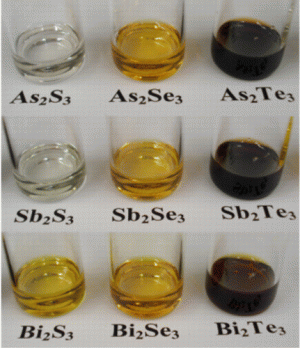New way to dissolve semiconductors holds promise for electronics industry

Semiconductors, the foundation of modern electronics used in flat-screen TVs and fighter jets, could become even more versatile as researchers make headway on a novel, inexpensive way to turn them into thin films. Their report on a new liquid that can quickly dissolve nine types of key semiconductors appears in the Journal of the American Chemical Society.
Richard L. Brutchey and David H. Webber note that making low-cost, semiconducting thin films on a large scale holds promise for improving a number of electronic applications, including solar cells. The problem has been finding a liquid that can dissolve semiconductors so that they can be subsequently solution-processed using inexpensive methods. Hydrazine can do the trick for many of these materials, but as a compound that is sometimes used in rocket fuel, it is explosive and highly toxic. It's also a poor option for making semiconducting thin films en masse. Brutchey and his team decided to search for a safer solution.
They found an answer in a mixture of two compounds that could dissolve a set of important semiconducting materials called chalcogenides at room temperature and normal air pressure. The researchers state, "We believe these initial results indicate that the chemistry can be further extended to other families of chalcogenide materials and may hold promise for applications that would benefit from solution deposition of semiconductor thin films."
More information:
"Alkahest for V2VI3 Chalcogenides: Dissolution of Nine Bulk Semiconductors in a Diamine-Dithiol Solvent Mixture" J. Am. Chem. Soc., 2013, 135 (42), pp 15722–15725
DOI: 10.1021/ja4084336
Abstract
The ability to solution deposit semiconductor films has received a great deal of recent attention as a way to potentially lower costs for many optoelectronic applications; however, most bulk semiconductors are insoluble in common solvents. Here we describe a novel and relatively nonhazardous binary solvent mixture comprised of 1,2-ethanedithiol and 1,2-ethylenediamine that possesses the remarkable ability to rapidly dissolve a series of nine bulk V2VI3 chalcogenides (V = As, Sb, Bi; VI = S, Se, Te) at room temperature and atmospheric pressure. After solution deposition and low-temperature annealing, the chalcogenides can be fully recovered as good quality, highly crystalline thin films with negligible organic content, as demonstrated for Sb2Se3 and Bi2S3.
Journal information: Journal of the American Chemical Society
Provided by American Chemical Society



















